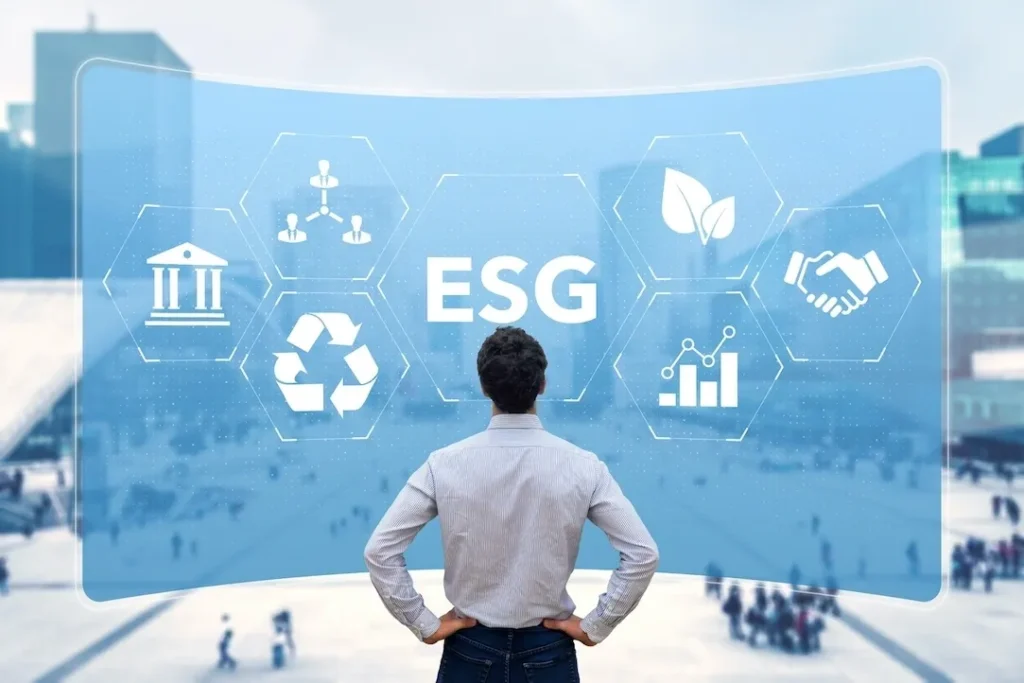
AI and ESG: Smarter, More Accountable Businesses
Discover how AI is transforming ESG into a smarter operating system, enabling data-driven decisions, transparency, accountability, and sustainable growth.

In the ever-evolving world of business, one thing has become clear: ESG (Environmental, Social, and Governance) considerations have quickly moved from being a “nice-to-have” to a must-have factor influencing investment decisions, partnerships, and business strategies across industries. The ESG landscape is shifting, and to stay competitive, organizations must integrate these factors into their decision-making processes.
And that’s where ESG due diligence comes in. What exactly does ESG due diligence (DD) entail? In simple terms, it’s the process of systematically evaluating the environmental, social, and governance aspects of a potential investment, partnership, or business operation.
Now, let’s break this down step by step, focusing on how you can ensure a robust and thorough due diligence process, and—of course—provide you with a handy checklist for easy reference. Trust me, by the end of this article, you’ll be well on your way to conducting your own thorough ESG due diligence.
Before we dive into the specifics of ESG due diligence, let’s take a second to reflect on why it’s crucial, especially in today’s business world. The need for sustainability and ethical practices is growing—fast. Governments, investors, and consumers alike are demanding more transparency and accountability from companies. ESG is not just a regulatory requirement; it’s also a competitive advantage that can lead to higher returns and lower risks.
Think about it: by conducting ESG due diligence, you’re ensuring that your business decisions align with sustainability goals, improve governance practices, and build a stronger, more resilient brand. So, how do you ensure your due diligence process is up to par? Let’s break it down.
Ready to get into the nitty-gritty of ESG due diligence? Awesome. This step-by-step guide will walk you through the essential components of the process, from identifying risks and opportunities to integrating ESG into decision-making.
First things first—let’s talk about risks and opportunities. I can’t stress this enough: understanding the specific ESG risks and opportunities associated with your potential investment or partnership is the starting point. You don’t want to jump in without knowing where the landmines are.
Industry-Specific Risks
Different industries face different ESG risks. For example, in the energy sector, climate change and carbon emissions might be top of mind, whereas in the apparel industry, labor rights and supply chain transparency take center stage. It’s essential to assess these risks within the context of your specific sector and business environment.
Regulatory Landscape
Did you know that ESG regulations are tightening globally? Whether it’s carbon reporting mandates or new labor laws, understanding the regulatory environment in your region and across the globe is crucial. The UAE, for instance, has specific regulations concerning sustainability and social governance that companies must adhere to. ESG training can help your team stay ahead of these evolving requirements.
Market Trends
And let’s not forget about market trends. Consumers are demanding sustainability, and investors are looking for companies with solid ESG frameworks. Market research, industry reports, and consumer sentiment all provide valuable insights into where opportunities lie—and where risks might lurk.
Now that you’ve identified the risks and opportunities, it’s time to dig into the actual performance. How do you evaluate the ESG performance of a company or potential partner? It’s time to dive into some hard data.
Environmental Metrics
Start by evaluating the company’s carbon footprint, water usage, waste management practices, and overall environmental impact. Are they reducing their carbon emissions or increasing them? Are they using renewable energy? These metrics will give you a clear picture of their environmental practices.
Social Metrics
On the social side, look at labor practices, diversity and inclusion efforts, community impact, and overall employee satisfaction. Is the company promoting fair wages? How do they handle worker rights and supply chain management? This is where understanding a company’s social responsibility comes into play.
Governance Metrics
Finally, evaluate the company’s governance structure. This means understanding their board composition, executive compensation, and corporate ethics. How transparent are their decision-making processes? How diverse and accountable is their leadership? Poor governance can lead to massive reputational damage, and we all know how important trust is in business.
You know what they say—the more perspectives, the better. Engaging with stakeholders gives you a holistic view of the company’s ESG performance and potential red flags. And trust me, this step is critical.
Internal Stakeholders
First, gather insights from within the company—employees, leadership, and relevant departments such as finance, sustainability, and legal. Their input will help you understand the internal dynamics and how seriously the company is taking ESG factors.
External Stakeholders
But that’s not all. You also need to engage with external stakeholders—suppliers, customers, local communities, NGOs, and any other relevant parties. Their feedback will give you a more comprehensive view of the company’s social impact. You can conduct surveys, interviews, and even focus groups to get their perspectives.
Here comes the fun part—integrating everything you’ve learned into your investment or business decision-making process. ESG should never be an afterthought. In fact, the insights from your ESG due diligence should be woven into every step of the decision-making process.
Weighing ESG Against Financial Metrics
Let’s get real—ESG factors can sometimes feel like soft metrics. But they aren’t. They should be evaluated alongside traditional financial performance. You can use an ESG scoring system or framework to assess how the company aligns with ESG values and where they stand in terms of sustainability.
Cross-Department Collaboration
This is not a one-person job. Integrating ESG factors into decision-making requires collaboration across departments. Whether it’s finance, sustainability, legal, or operations, cross-functional collaboration ensures that every angle is covered, and ESG factors are taken into account holistically.
Hold up—due diligence doesn’t stop after the deal is done. ESG is a dynamic, ever-evolving field, and continuous monitoring is key to ensuring that your company or investment remains aligned with ESG standards over time.
Regular ESG Reporting
Track ESG performance metrics regularly through detailed ESG reporting. Disclose relevant data to stakeholders, and set goals for ongoing improvement. Remember, transparency and accountability are critical.
Review and Adjust Strategies
Finally, don’t forget to review the ESG performance periodically. New risks, regulations, and opportunities can emerge, so it’s essential to adapt your ESG strategy as needed to stay on top of your game.
ESG Due Diligence Checklist: Your Quick Reference
Before we wrap up, here’s a handy ESG due diligence checklist to help ensure you’ve covered all bases. Print it out, and keep it on hand for your next ESG due diligence review.
ESG Due Diligence Checklist:
To make sure your ESG due diligence process is thorough and effective, follow these best practices:
ESG due diligence isn’t just a checklist—it’s a vital process that can lead to more sustainable investments, stronger partnerships, and long-term business growth. By following this step-by-step guide, you can ensure that your company stays ahead of ESG risks, aligns investments with your sustainability goals, and meets the growing demand for ESG-focused investment.
At IFRSLAB, we specialize in providing ESG advisory services UAE and ESG consulting UAE to help businesses navigate the complexities of ESG due diligence. Ready to integrate ESG into your strategy and make responsible, informed decisions? Contact us today to learn how we can support your ESG journey and help you thrive in the ESG landscape.
ESG due diligence is the process of evaluating the ESG factors of an investment or partnership to identify risks, opportunities, and alignment with sustainability goals.
It helps businesses mitigate risks, align with sustainability goals, attract ESG-focused investment, and ensure compliance with evolving regulations, ultimately contributing to long-term financial performance.
The key steps include identifying ESG risks and opportunities, evaluating ESG performance metrics, engaging with stakeholders, integrating ESG findings into decision-making, and continuous monitoring and improvement.
ESG performance metrics include environmental factors like carbon emissions, social factors like labor practices, and governance metrics like board composition and transparency. You can evaluate these using public reports, sustainability disclosures, and third-party ratings.
By identifying potential ESG risks such as regulatory violations, environmental damage, or social unrest, businesses can avoid investments that may result in reputational or financial damage.
Stakeholder engagement, including feedback from employees, suppliers, customers, and communities, provides critical insights into a company’s social and environmental impact and can help uncover risks and opportunities.
ESG databases like MSCI ESG Research and Sustainalytics provide data and ratings on a company’s ESG performance, helping investors and businesses make informed decisions.
Common ESG frameworks include the Global Reporting Initiative (GRI), Sustainability Accounting Standards Board (SASB), and Task Force on Climate-related Financial Disclosures (TCFD), which guide the assessment and reporting of ESG factors.
Use an ESG scoring system or criteria that weigh ESG factors alongside traditional financial metrics. Collaboration between departments like finance, sustainability, and legal ensures comprehensive decision-making.
ESG due diligence should be an ongoing process, not a one-time event. Regular reviews and updates ensure that your ESG practices remain aligned with evolving risks, regulations, and market conditions.

Discover how AI is transforming ESG into a smarter operating system, enabling data-driven decisions, transparency, accountability, and sustainable growth.

Explore how ESG is transforming the future of architecture, driving sustainable design, responsible construction, and long-term environmental impact.

Discover how ESG principles are accelerating the solar transition, helping businesses adopt responsible energy, reduce emissions, and build long-term value.
UAE : (+971) 52 710 0320 PAK : (+92) 300 2205746 UK : (+44) 786 501 4445
Office 2102 Al Saqr Business Tower 1, Sheikh Zayed Road
S-25, Sea Breeze Plaza Shahrah-e-Faisal, Karachi
Office#1304, 13th Floor, Al Hafeez Heights, Gulberg III
P.O. Box 71, P.C. 100, Muscat
104 Broughton Lane Salford M6 6FL,
UAE : (+971) 52 710 0320 PAK : (+92) 300 2205746 UK : (+44) 786 501 4445
Office 2102 Al Saqr Business Tower 1, Sheikh Zayed Road
S-25, Sea Breeze Plaza Shahrah-e-Faisal, Karachi
Office#1304, 13th Floor, Al Hafeez Heights, Gulberg III
104 Broughton Lane Salford M6 6FL
P.O. Box 71, P.C. 100, Muscat
Typically replies within a day